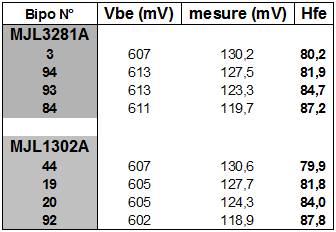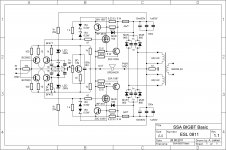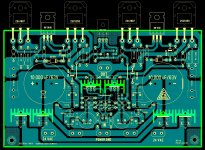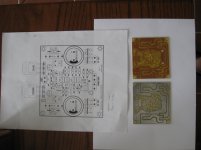SSA BIGBT Basic
Here we have the SSA BIGBT Basic complete package for all potential builders. Enjoy.
Here we have the SSA BIGBT Basic complete package for all potential builders. Enjoy.
Attachments
Hi Lazy Cat,
I had a similar circuit with IRF620/IRFP620 and i had problems with a stable BIAS.
I also would make thicker traces for the power-BJT in the layout.
But I like your circuit
SSA BIGBT Basic had a change +/-20% bias change from 24-75°C.
I think the traces are just fine for the estimated power levels. Of course it would be better to have thicker traces.
Thanks, it sounds very good.
Yes the schematic of the real amplifierwe have enuff small amps around here, when can we see the scaled up version ...
The Big one .....
I am working on this one.
Hi Lasy Cat, i have a bunch of MJL3281/1302 laying around. I take a look at SC5359/SA1987 datasheet and they seems to me to quite near on MJL characteristics, only toshiba cob is 360pf as Onsemi cob is 600pf the reste is quite the same. Do you think they could be good candidate for SSA BIGBT?
I have a pair of 300Va 2x25V laying under bench as a pair of 200x200x40mm heatsink too. These could be a good begining for SSA BIBGT
Regards Marc
You can use yours as well. Pay attention to NPN/PNP hFE matching within BIGBT.
It would be great if Alex prepare an extra PCB for all-japan bjt devices with respecting Nico's circuit.
I wonder why all pcbs have power supply unit? Is there reason for that amplifier should be close to power unit? If it is not mandatory, PCBs should be bare in my opinion.
For 50 Watt-ers it is reasonable to have power supply on board, so you only have to connect transformer, speaker and input. Some kind of builder's friendly version.
I wonder why this thread only have four stars? Have you all voted or is there something missing?
Because people think that you and me are joking around with schematics. But if they would have a chance to listen to SSA I think the situation would change dramatically.
MiiB I successfully built the one that you are referring to last year in Decmeber, it sounded stunning and is currently my main listening amplifier.
Nico, can you please make any sound comparison to SSA, are they close?
Nico,
It has only four stars because I have not yet accessed it 10k times.
But I'm working on it......
Hugh
You're welcome Hugh.
BTW I sent you PM.
You can use yours as well. Pay attention to NPN/PNP hFE matching within BIGBT.
Hi Lasy Cat thanks for response.
I look at my MJL Stock and can use these 8 unit for BIGBT

I have done HFE/VBE mesure at 55mA
Marc
Hi Lasy Cat thanks for response.
I look at my MJL Stock and can use these 8 unit for BIGBT

I have done HFE/VBE mesure at 55mA
Marc
All Vbe are fine, very close to each other.
Pair the closes hFE NPN/PNP matches, for example NPN 81,9 in pair (within the same BIGBT) with PNP 81,8 etc.
All Vbe are fine, very close to each other.
Pair the closes hFE NPN/PNP matches, for example NPN 81,9 in pair (within the same BIGBT) with PNP 81,8 etc.
Yes that's what i had in mind, i present them ordred 3281 N°3 with 1302 N°44, N°94 with N°19.....etc
Marc
Nico, can you please make any sound comparison to SSA, are they close?
When you say are they close, do you mean in the next room or are they close in sound?
Unfortunately my system in my listening room consists of eight amps driving eight individual loudspeaker in a multi speaker stereo set-up, so it is not possible really to take the Lazy Cat across and connect it.
The LC is the kind of amp that you cannot take out of the workshop because once you listen to it, you cannot turn it off and it remains on the workbench playing instead of being finished.
The amp has an exceptionally good sound. I am not an audio reviewer but if transparent can be a description then that is what it is. Unlike most projects you tend to listen to the equipment, in this case you tend to listen to the music for a lack of better description.
I do not need to listen loud, the music comes through in a way that it sounds extremely satisfying, but do not make any mistake, even for the "baby" 40 watt amp that this one is, you become pretty anxious whether the speaker is going to survive when pushing it. It just continues to go louder.
If some of you ever listened to a KRELL KSA50, although it is only a 50 watter, it sounds a lot louder than what you expect. Now this amp follows the same reasoning, it gives the impression of playing louder than you would expect.
My Lazy Cat amp is going to stay where it is until such time that I have redesigned a PCB that tips the 100 - 150 watt scale (that is what my requirements are), designed a proper power supply, since I like regulated supplies because it seems to bring out even more detail in an amp.
I will also design an aesthetically pleasing box and have them fabricated into 4 stereo amps because I am old school and like a full rack of equipment looking as impressive as it sounds.
Unfortunately this is not a week-end task and will take a while, but the confidence I have that it will sound absolutely great and become the focus point of my system convinced me that I am prepared to spend a few thousand bucks on them.
That is about all I can say about the design, with the right power supply mechanically sound container taking all the necessary precautions to avoid noises and buzzes and the like, this amp ranks one of the best I have experienced.

Nico
Last edited:
The LC is the kind of amp that you cannot take out of the workshop because once you listen to it, you cannot turn it off and it remains on the workbench playing instead of being finished.
The amp has an exceptionally good sound. I am not an audio reviewer but if transparent can be a description then that is what it is. Unlike most projects you tend to listen to the equipment, in this case you tend to listen to the music for a lack of better description.
The same story happened to me too, I would just listen to SSA and leave it in its web form. It looks like the satisfaction reflex prevents me to perform any changes. It is very interesting pshycological phenomena, but I have to dismantle this spider's web and finally make some serious built out of this schematic.
Thank you Nico for sharing your impressions, appreciate it a lot.

Member
Joined 2009
Paid Member
Since I didn't yet find an all-BJT version I like the look of, and given those words from Nico I think my future HT amp is more likely going to follow your version if I use this SSA architecture. I will be waiting to see how this develops in terms of pcb designs... bring it on !
Think this BIGBT is one hell off an idea....when making amplifiers the P and N side are always different....because the devices differ a bit..here You have the P&N included in something that resembles on singe device....
For more current capability you can double the BJT devices and still keep them under a single mossfet control....
I'll do some temp-step simulations with a lateral device (SK216-SJ79) to see how the BIGBT temp-co is...I have a feeling it will be slightly negative...If so I believe they could be the new Black in the amplifier output device world....
For more current capability you can double the BJT devices and still keep them under a single mossfet control....
I'll do some temp-step simulations with a lateral device (SK216-SJ79) to see how the BIGBT temp-co is...I have a feeling it will be slightly negative...If so I believe they could be the new Black in the amplifier output device world....
- Status
- This old topic is closed. If you want to reopen this topic, contact a moderator using the "Report Post" button.
- Home
- Amplifiers
- Solid State
- Simple Symetrical Amplifier



